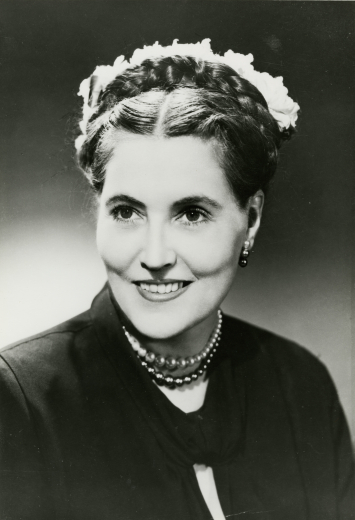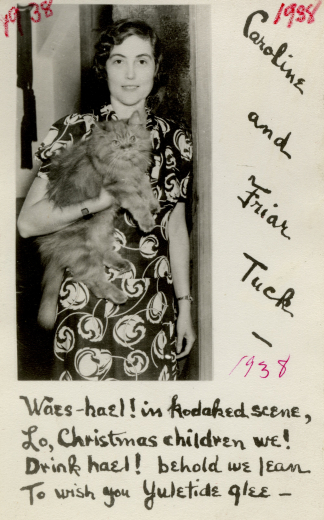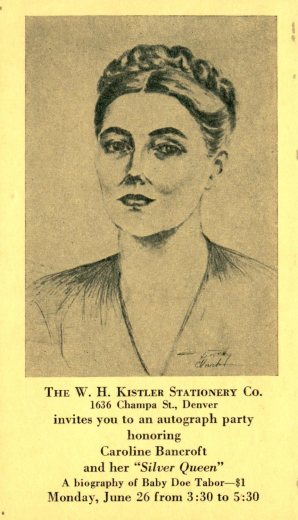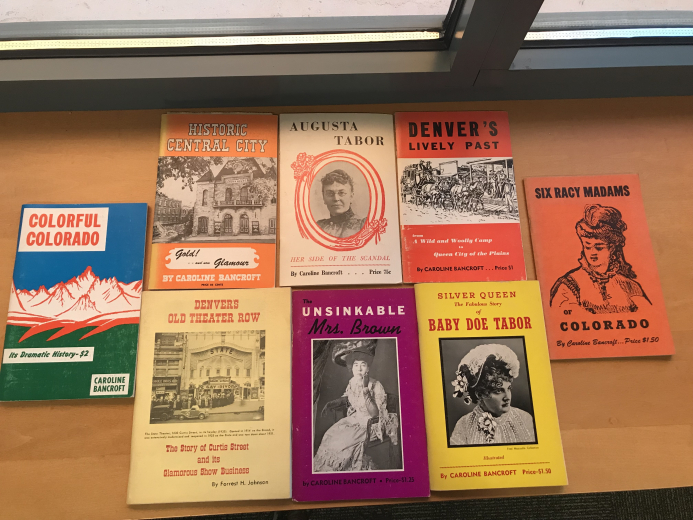Historian, journalist, and philanthropist whose stories about Colorado history helped spark new interest in the state's past.
Caroline Bancroft was born on September 11, 1900, in Denver, Colorado. Caroline's father, George, was a mining engineer, while her mother, Ethel Norton Bancroft, was a social worker. The Bancrofts had two children, Caroline and Ethel (nicknamed Peggy).
Both of Caroline's parents came from extremely wealthy families, and the Bancrofts were considered one of the most important families in turn-of-the-century Denver. Caroline's grandfather, Dr. Fredrick Jones Bancroft, was the founder of both the Colorado Historical Society and the Colorado Medical Society.
However, the Bancrofts often struggled for money. This was because Caroline's father often gambled the family money or spent it on alcohol.
Caroline did not have a happy childhood. Her father could be very cruel, and Caroline developed a lifelong dislike of men because of the way her father treated her, her mother, and her sister. However, the Bancrofts were able to enjoy a lot of time in the mountains of Colorado. Caroline had a love of hiking and visiting the outdoors from these experiences.
Caroline was allowed to travel with her father to inspect mines across the state. George Bancroft had Caroline accompany him during mining trips because of her excellent knowledge of horses. She spent many nights hearing stories from the mountain townspeople about the old days of the West. She rejected the traditional role that was expected of women and girls at the time and enjoyed hearing folktales and going on rugged adventures.
It did not take Caroline long to begin writing stories of her own. Caroline submitted her first story for publication when she was eleven years old. It was rejected, but Caroline continued writing. She would be published over fifty times throughout her life.
Caroline's parents could not afford to send her to the private school the rest of her friends attended, so she enrolled at North High School in Denver. The Bancrofts owned a dance studio, and Caroline taught dance lessons after school to earn money of her own. Caroline was a skilled ballerina, but was passed over by elite dance teachers because of her height - Caroline was just under six feet tall.
Shortly after Caroline graduated from North High School, she decided to take the money she earned as a dance teacher and run away from home. She could not stand her parents' constant arguing or her father's angry outbursts. Caroline traveled to New York, where her mother's family lived. In New York City, Caroline decided to pursue her dream of dancing onstage.
She auditioned for the famous Ziegfeld Follies. Caroline was originally rejected from the Follies because the casting director thought she was too tall, too heavyset, and that her hair was too dark. Caroline convinced the directors to allow her to work as an understudy for the regular dancers. She never got to dance on stage, as her mother's family forced her to return home with them before she had the chance.
Caroline's aunt paid for her to attend Smith College in Massachusetts. At Smith, Caroline studied literature and drama. She was a very popular student, and was involved in many school groups. She wrote, acted in, and directed school plays.
Caroline graduated from college in 1923, the same year her parents divorced. It was a very high-profile divorce that was in all the gossip columns. Caroline was very embarrassed by all the negative press her family received. She decided not to return to Denver after graduation.
Instead, she took a job as a second and third grade teacher at a school for extremely wealthy children in Connecticut. Caroline taught horseback riding and dance in addition to regular subjects. Caroline liked the job because she was able to lead summer trips for the school around the world. Caroline traveled with her students on a cruise ship. As soon as the cruise ship docked, Caroline was free to leave her students and visit wherever she wanted. Caroline traveled to Asia, the Middle East, and Europe on these trips.
Caroline did not give up on her dream of becoming a writer, and went out of her way to meet many famous expatriate authors living in Europe through her travels. She became friends with the British author W. Somerset Maugham and many other writers of the 1920s.
Caroline eventually decided to leave her job as a teacher and live abroad like the writers she admired so much. Caroline hoped to marry one of the very wealthy men living abroad so she could spend her time traveling and writing.
Caroline was engaged four times, but never married. Each time she broke off the engagement before the wedding. Caroline worried that she would "end up with a husband like my father." After the end of her last engagement, Caroline decided she would stay single. She liked being able to do whatever she wanted, whenever she wanted too much to have a husband or family.
Caroline spent a year living in India, where she became friends with Rabindranath Tagore, the first non-European to win a Nobel Prize in Literature. Caroline had to leave India when she developed tuberculosis.
Caroline had no desire to return to Colorado after her parents' divorce, but Colorado was actually one of the best places to treat tuberculosis. Caroline returned home to visit Denver's tuberculosis hospitals.
She moved in with her mother, Ethel. Ethel had won the Bancroft family home in the divorce. However, Ethel did not earn much money as a social worker, and had to rent out the top floors of the Bancroft's large Cheesman Park home. Caroline and her mother lived in the basement.
Shortly after Caroline returned to Denver, she went on a trip with her father to visit mining sites just as she had done as a child. While in Leadville, Caroline's father suggested they visit one of his old friends who owned the Matchless Mine. Caroline was terrified when they pulled up to the mine and a haggard old woman ran out, shouting and pointing a rifle at the Bancrofts.
The old woman soon recognized Caroline's father, and invited them into her cabin to visit. The woman was Baby Doe Tabor, once one of the richest women in America.
She lived in a shack at the Matchless Mine, although the mine had gone bankrupt long ago. Baby Doe and Caroline's father talked about mining, and Baby Doe admitted that her 'rifle' was really a cane she had carved to look like a gun so she could scare off visitors.
Caroline remembered that Baby Doe did not like strangers, and did not like women. Twenty-six year old Caroline had no idea during this uncomfortable visit that she would be remembered as one of the most famous historians about the life of Baby Doe Tabor.
Caroline recovered from tuberculosis, and decided she needed to find a job. Caroline contacted Frederick Bonfils, one of the owners of the Denver Post. Frederick Bonfils was the Bancrofts' neighbor, and Caroline had known him since she was a little girl. Bonfils told Caroline they were not hiring any more news reporters. Caroline asked if she could work as a literature reviewer. The Denver Post did not have a literature section. She told Bonfils that all the major newspapers had literature sections, and the Post should have one if it wanted to be more than a small-town paper. Bonfils agreed, and Caroline became the Denver Post's first literary editor.
Caroline was able to use her society and literary connections to interview some of the most important writers of the time. Caroline's work was very well received. Caroline also began teaching literature courses for the University of Colorado at Boulder.
Some of the editors at the Denver Post disliked Caroline and her literary section. They thought she acted like her famous family made her better than other people. They thought her literature column was too boring for the readers of the Denver Post. In order to keep her job, Caroline agreed to start interviewing famous people of Colorado's past. Her interviews were always funny and intriguing. They became very popular.
Caroline soon realized she needed more than just memories of miners' stories from her childhood to do her interviews well. She needed to learn more about Colorado's history. She began taking classes at the University of Denver. She enrolled in one course at a time. Eventually, Caroline had taken so many classes that she only needed to write a thesis to graduate with a masters degree in Western History.
Caroline wrote her thesis on the history of Central City, a near ghost town she was fascinated by her entire life. The thesis, "Gulch of Gold," would be her first official Western History piece.
Caroline finished her masters degree in 1943, at the height of World War II. However, once the War ended two years later, Colorado became a popular tourist destination for people just starting to experience postwar prosperity. Caroline realized that many of these tourists wanted to learn more about the state they visited, but all the existing histories of Colorado were large, scholarly works. She wanted to write something fun and informal that people would enjoy reading while on vacation.
She decided to rework her thesis into a small book that people could read while visiting Central City. She printed copies of "Gulch of Gold" and sold them in hotels and visitor centers in Denver and Central City. The booklets sold for fifty cents a piece. They were so popular that they sold out within weeks. Caroline knew then that she was able to bring Western history to a wide audience.
Caroline began researching and writing full time. She eventually wrote over thirty booklets about the history of Colorado. Many of her booklets were inspired by the interviews she had done for the Denver Post.
For instance, one of her interviews was with Sue Bonny, Baby Doe Tabor's closest friend. Although Baby Doe had died years before, Sue Bonny was able to tell her story. Caroline was fascinated by Baby Doe's rags-to-riches-to-rags life. She spent months interviewing people who had known Baby Doe, and learning all about the Tabors and their history. Her booklet "Silver Queen: The Fabulous Story of Baby Doe Tabor" was by far her most popular work. Most Coloradans did not know anything about Baby Doe Tabor until Caroline wrote about her. Baby Doe is now remembered as one of Colorado's most interesting historical figures thanks to Caroline's booklet.
Caroline's histories began to earn her a lot of money. She and her mother were able to move back into their house, instead of just living in the basement. Within a few years, Caroline was very wealthy with all the money she earned from her booklets.
Her stories began to become famous outside of Colorado as well. Caroline's booklet on Molly Brown, "The Unsinkable Mrs. Brown" was adapted into a musical called "The Unsinkable Molly Brown." The musical is still performed today.
Caroline was well known for her temper, and often fought with other historians. She tried to sue the producers of the musical "The Ballad of Baby Doe" because she felt she owned the rights to Baby Doe's story. Caroline did not mind controversy, and was known to say that she "cherished her feuds as much as her friends."
Some people accused Caroline of making up facts to tell a more interesting story. Caroline did admit to this in her later years, saying it was more important that people were reading history than that every part of that history was accurate. She freely admitted to making up the dialogue for her 'characters' (Caroline considered herself a novelist as much as a historian). Caroline thought that even if a person didn't actually say a particular quote, they should have.
In fact, one of the most famous parts of Baby Doe's story - that Horace Tabor's last words asked Baby Doe to "hold on to the Matchless Mine" - was Caroline's invention. Caroline defended herself by saying this story made sense - why else would Baby Doe have stayed at the Matchless Mine long after it was worthless?
Caroline did not hold back on her opinion of historical figures, either. She famously disliked Molly Brown, despite all the money she earned writing about her. In Caroline's mind, Molly Brown was "such a fraud. She lied about everything."
Caroline was actively involved in historic preservation in Denver, Central City, Blackhawk, Leadville, Aspen, and Fairplay, in addition to many other Colorado cities. She loved the history of Colorado and wanted to share it with people.
Although Caroline sometimes focused more on telling a good story than telling the strict truth, her stories were so good that generations of people became interested in Colorado history who may not have cared about it otherwise. Caroline collected many historic items from the state, and eventually donated this large and expensive collection to Denver Public Library's Special Collections and Archives Department.
Caroline left Colorado to live in Hawaii during her last years. She developed cancer and thought time on the beach would help. When Caroline passed away at eighty-five, she left most of her large fortune to different charities and historic groups. Caroline planned her own elaborate funeral in Denver before she died. She is buried at Fairmount Cemetery in Denver, across from the famous madam Jennie Rogers - one of Caroline's favorite figures in Colorado history.
Part of her estate went to the Denver Public Library to create the Caroline Bancroft Prize. The prize is given each year to "the best book on Colorado or Western History." Recent Caroline Bancroft Prize winning books include The Earth is Weeping: The Epic Story of the Indian Wars for the American West (2017), Warrior Nation: A History of the Red Lake Ojibwe (2016), Encounters at the Heart of the World: A History of the Mandan People (2015), and The Road to Chinese Exclusion: the Denver Riot, 1880 Election, and Rise of the West (2014).
Today, Caroline Bancroft herself is an important part of Colorado's history. Without her work to preserve history and share Colorado's most exciting stories, much of Colorado's past would have been forgotten.
accompany - to go with someone as a companion or escort
elite - a superior or exclusive group
Ziegfeld Follies - a large theater show featuring dancers in elaborate costumes. It was the most famous entertainment of the 1910s and 1920s.
understudy - a person who practices with a theater or dance group so they can fill in if one of the regular cast members becomes sick or injured
expatriate - people living abroad
tuberculosis - a lung disease
intriguing - fascinating
thesis - a work of original research that must be completed before earning a degree
prosperity - wealth
controversy - a heated public disagreement
cherish - to hold dear
feud - a long and bitter quarrel
Caroline Bancroft thought telling an interesting story was more important than making sure every fact in a history was correct.
- Do you agree or disagree with Caroline's take on history? Why?
Caroline wrote many books on the subject of Baby Doe Tabor. Caroline thought she was one of the most interesting people in Colorado history.
- If you were going to write a book about one of Colorado's most famous people, who would you write about?
- Why did you choose them?
The Bancroft Family Papers (WH1089): Manuscript Collection donated by Caroline Bancroft. Includes photographs, letters, and drafts from Caroline. Also contains information and artifacts from other Bancroft family members, including Caroline's famous grandfather Frederick Bancroft. These can be viewed in person at the Special Collections and Archives Department.
Caroline Bancroft Clipping Files (Newspaper and journal articles about Caroline Bancroft. These can be viewed in person at the Special Collections and Archives Department.)
Caroline Bancroft Prize Information
Caroline Bancroft in the Denver Public Library Digital Collections
Books about Caroline Bancroft:
High Altitude Attitudes: Six Savvy Colorado Women
Women of Consequence: The Colorado Women's Hall of Fame
Augusta Tabor: Her Side of the Scandal
The Brown Palace in Denver: Hotel of Plush, Power, and Presidents
Colorado's Lost Gold Mines and Buried Treasure
Colorful Colorado: Its Dramatic History
Dentistry in Colorado
Denver's Lively Past: From a Wild and Wooly Camp to Queen City of the Plains
Estes Park and Trail Ridge, Their Dramatic History
Famous Aspen: Its Complete History as Guide and Souvenir
Famous Aspen: Its Fabulous Past - Its Lively Present
Folklore of the Central City District, Colorado
Glenwood's Early Glamor
Grand Lake from Utes to Yachts: Its Legendary History
A Guide to Central City, Colorado and Its Surrounding District
Gulch of Gold: A History of Central City, Colorado
Historic Central City: Its Complete Story as Guide and Souvenir
Literary Treatments of the Central City District
The McLean Family
The Melodrama of Wolfhurst: Celebrated Colorado Show Place
Mile High Denver: Its Complete Story as Guide and Souvenir
Silver Queen: The Fabulous Story of Baby Doe Tabor
Six Racy Madams of Colorado
Tabor Luck
Tabor's Matchless Mine and Lusty Leadville
Trail Ridge Country: The Romantic History of Estes Park and Grand Lake
Two Burros of Fairplay: Morsels of History for Young and Old
Unique Ghost Towns and Mountain Spots
The Unsinkable Mrs. Brown
The Unsinkable Molly Brown Cookbook
Caroline Bancroft Biography - Colorado Encyclopedia
Caroline Bancroft in the Colorado Women's Hall of Fame




